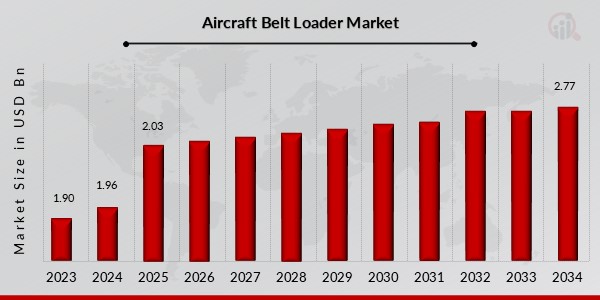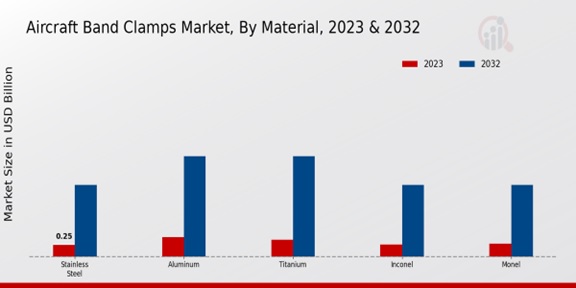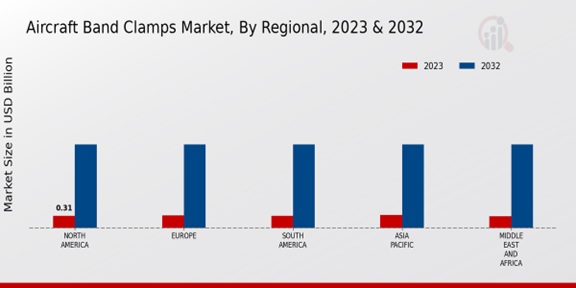Aircraft Belt Loader Market Overview
Aircraft Belt Loader Market Size was estimated at 1.96 (USD Billion) in 2024. The Aircraft Belt Loader Market Industry is expected to grow from 2.03 (USD Billion) in 2025 to 2.77 (USD Billion) by 2034. The Aircraft Belt Loader Market CAGR (growth rate) is expected to be around 3.5% during the forecast period (2025 - 2034).

Source: Primary Research, Secondary Research, MRFR Database and Analyst Review
Key Aircraft Belt Loader Market Trends Highlighted
Key Market Drivers: Rising air travel demand and increasing passenger traffic are driving the need for efficient ground support equipment. Modernization of airport infrastructure to handle larger aircraft, coupled with the expansion of low-cost carriers, has fueled the demand for advanced aircraft belt loaders.
Opportunities to be Explored: Advanced technologies such as electric and hybrid belt loaders offer opportunities for improved efficiency, reduced emissions, and lower operating costs. Innovation in automation and remote control systems will enhance safety and streamline operations. Partnerships between manufacturers and airlines can foster tailored solutions and specialized designs.
Trends in Recent Times:
The industry is witnessing a shift towards environmentally sustainable solutions. The adoption of electric belt loaders reduces carbon footprint and aligns with aviation's drive towards green operations. Additionally, integrated systems that combine belt loaders with other baggage handling equipment are becoming increasingly common, enabling seamless and efficient ground-handling processes.
Aircraft Belt Loader Market Drivers
Increasing Demand for Air Travel
The constant growth of the number of air travelers resulted in the increased demand for support for air travel. One such machine is the aircraft belt loader, the device used for loading and unloading baggage and cargo to and from an aircraft. This machine is essential for letting flights depart and arrive on time. As the air travel industry keeps on growing, the demand for aircraft belt loaders will continue to increase. In addition to the increase in the number of air travelers, the boost in e-commerce activity leads to another important market driver.The growing interest of people to shop online resulted in a significant rise in the volume of air cargo- the cargo that can be loaded and unloaded with the help of the aircraft belt loader. These drivers are considered the two most significant for the aircraft belt loader market and are expected to continue to contribute to its growth in the future.
Technological Advancements
Technological advancements are another key market driver for the aircraft belt loader market. New and improved ways to enhance the efficiency and safety of these machines are being developed on a regular basis. For instance, some of the newest aircraft belt loaders are fitted with sensors that can detect the weight and size of the baggage and cargo. These loaders can then adjust their settings on their own to ensure safe and smooth handling of the load.Moreover, the market is witnessing the advent of electric and hybrid belt loaders. Not only are these machines environmentally friendly since they do not emit carbon dioxide, but this feature also allows users to cut down on their operating costs, which can be very high. Thus, as technology continues to evolve, we will see more responses and more efficient aircraft belt loaders catering to this market.
Rising Labor Costs
A rise in labor costs is another factor that has been increasing the demand for aircraft belt loaders. There has been a steady rise in the cost of labor in different parts of the world. Airlines and other ground handling agents have to part with considerable amounts of money in the recruitment and employment of workers to load and offload baggage and cargo from their aircraft. The labor costs take the most substantial chunk of the income generated.However, purchasing and utilizing aircraft belt loaders by this airline and other ground handling agents have helped reduce labor costs.
Aircraft Belt Loader Market Segment Insights:
Aircraft Belt Loader Market Type Insights
The aircraft belt loader market is split into self-propelled belt loaders and towable belt loaders by type. In 2023, the self-propelled belt loader segment is projected to account for a higher share of the turning and scanning market as the new airports and airlines adopt the solution to improve the efficiency of their operations. A self-propelled belt loader is more effective as it does not require a tow vehicle and can easily be moved by the employee around the airport tarmac to the desired location. In addition, self-propelled belt loaders are better suited for load and unload functions as they relatively quickly lift bags and freight.Overall, the towed belt loader segment is expected to grow at a steady pace as it requires low upfront costs and fits into the budgets of many schools and airlines. Towable belt loaders are used for limited transport and load and unload trips and are also easier to manage and restore, ultimately the most reasonable choice over the longer term. Overall, the aircraft belt loader market is predicted to grow at a slow pace during the forecast period because of the increasing demand for emissions, the emissions-compliant management of airlines, and the efficient and regular systems for goods and luggage processing. The self-propelled belt loader market allows a larger share of the market, while the towable belt loader market grows at a steady rate.

Source: Primary Research, Secondary Research, MRFR Database and Analyst Review
Aircraft Belt Loader Market Capacity Insights
The Aircraft Belt Loader Market can be segmented by Capacity into 1-20 Tonnage, 21-50 Tonnage, 51-100 Tonnage, and Over 100 Tonnage. The 21-50 Tonnage segment already garnered the largest market share in the year 2023, producing over 45% of the Aircraft Belt Loader Market revenue. The demand for the product must be high in this range of capacity from the regional airports and cargo handling companies. The 51-100 Tonnage segment is projected to experience the highest growth as more and more wide-body aircraft are inducted and many major airports further expand their cargo operations.The Over 100 Tonnage segment is going to be the smallest in capacity and, as a result, in market share as well, but the Revenue from this segment is expected to increase at a good CAGR due to the growing demand for heavy-duty Aircraft Belt Loader to load huge aircraft and over-sized cargo.
Aircraft Belt Loader Market Power Source Insights
The Aircraft Belt Loader Market is segmented by Power Source into Diesel, Electric, and Hybrid. Among these, the Diesel segment held the largest market share in 2023, accounting for approximately 60% of the market revenue. The dominance of Diesel power sources is attributed to their reliability, cost-effectiveness, and wide availability of fuel. However, the Electric segment is projected to witness significant growth over the forecast period due to increasing environmental concerns and government regulations promoting the adoption of sustainable solutions. The Hybrid segment is also expected to gain traction as it offers a combination of the advantages of both Diesel and Electric power sources.
Aircraft Belt Loader Market Application Insights
The Aircraft Belt Loader Market is segmented on the basis of application into passenger aircraft, cargo aircraft, military aircraft, and business jets. The passenger aircraft segment is expected to hold the largest market share in 2023 and is projected to continue to dominate the market throughout the forecast period. The growth of this segment can be attributed to the increasing number of passenger aircraft being manufactured and delivered worldwide. The cargo aircraft segment is also expected to witness significant growth over the forecast period due to the increasing demand for air cargo transportation.The military aircraft segment is expected to grow at a steady pace, driven by the need for military aircraft belt loaders for military operations. The business jets segment is expected to experience moderate growth over the forecast period due to the increasing demand for business jets for corporate and private travel.
Aircraft Belt Loader Market Level of Automation Insights
Semi-automatic and fully-automatic aircraft belt loaders are the two main types in the Aircraft Belt Loader Market based on the level of automation. The Aircraft Belt Loader Market is anticipated to reach USD 2.5 billion by 2032, driven by rising air traffic and the need for efficient ground handling equipment. Semi-automatic aircraft belt loaders require an operator to control the loading and unloading process, while fully automatic loaders can operate independently. Fully-automatic loaders are more efficient and can save time and labor costs, but they also have a higher upfront cost.In 2023, the semi-automatic segment held a larger Aircraft Belt Loader Market share due to its lower cost and wider availability. However, the fully automatic segment is expected to grow at a faster rate in the coming years due to its increased efficiency and safety benefits. Overall, the Aircraft Belt Loader Market is expected to grow steadily in the coming years, driven by the increasing demand for air travel and the need for efficient ground handling equipment. The level of automation is a key factor in the Aircraft Belt Loader Market segmentation, and both semi-automatic and fully-automatic loaders are expected to play a significant role in the market's growth.
Aircraft Belt Loader Market Regional Insights
The regional segmentation of the Aircraft Belt Loader Market offers valuable insights into the market's geographical distribution and growth patterns. North America holds a significant share of the market, driven by the presence of major aircraft manufacturers and airlines, as well as a robust aerospace industry. Europe is another key region, with a large number of airports and airlines contributing to the demand for aircraft belt loaders. The APAC region is projected to witness significant growth in the coming years, owing to the increasing air travel and the expansion of the aerospace industry in countries like China and India.South America and MEA are expected to have a steady growth rate, driven by the growing aviation sector in these regions.

Source: Primary Research, Secondary Research, MRFR Database and Analyst Review
Aircraft Belt Loader Market Key Players and Competitive Insights:
Since the Aircraft Belt Loader Market industry is rather competitive, chief companies constantly look for ways to develop their strategies to offer products that will be able to gain higher profits. Being the major players in the current market, they execute massive investments in research and development. Furthermore, the progress of the aircraft belt loader market is driven by a higher demand for safe and effective baggage processing systems at airports. Even though the Aircraft Belt Loader Market Competitive Landscape is likely to be highly competitive, with the key companies possessing major shares of the market, many other operators will have chances to contribute to the industry development.The aircraft belt loader market is a industry that occupies leading positions in different regions such as North America, Europe, and Asia Pacific. These three regions are projected to demonstrate a considerable rise in the market in the near future. This growth will be stimulated by the increasing demand for air travel, the growing population’s income, and the appearance of advanced airport facilities. However, the Aircraft Belt Loader Market is not limited to the mentioned companies only; in particular, JBT Corporation should be present in the summary. IDEX Corporation is also a very successful player in the market, and it supplies a variety of flight belt loaders under its MK Diamond brand. As for the IDEX’s loaders, it is typical to meet the description “built to last, easy to operate, and dependable.” The company’s activity is focused on both North America and Europe; however, it operates in other regions as well. In addition, IDEX is particularly known for providing innovations at a reasonable price for aviation clients.
Key Companies in the Aircraft Belt Loader Market Include:
- Manti Technology
- HACTL
- Russiagate LLC
- TLD Group
- Swissport
- Mallaghan
- Dnata
- ITW GSE
- Menzies Aviation
- Airmar Group
- Worldwide Flight Services
- WFS
- JBT
- dnata
Aircraft Belt Loader Market Industry Developments
The Aircraft Belt Loader Market is poised to grow at a CAGR of 3.49% from 2024 to 2032, reaching a value of USD 2.5 billion by 2032. The growth of the market is attributed to the increasing demand for air cargo transportation and the need for efficient and safe loading and unloading of aircraft. The Asia-Pacific region is expected to witness the highest growth rate due to the rapid expansion of the aviation sector. Key players in the market include JBT, TLD, and CIMC. Recent developments in the market include the introduction of electric and hybrid belt loaders to reduce emissions and improve sustainability.
Aircraft Belt Loader Market Segmentation Insights
Aircraft Belt Loader Market Type Outlook
- Self-Propelled Belt Loader
- Towable Belt Loader
Aircraft Belt Loader Market Capacity Outlook
- 1-20 Tonnage
- 21-50 Tonnage
- 51-100 Tonnage
- Over 100 Tonnage
Aircraft Belt Loader Market Power Source Outlook
Aircraft Belt Loader Market Application Outlook
Aircraft Belt Loader Market Level of Automation Outlook
- Semi-Automatic
- Fully-Automatic
Aircraft Belt Loader Market Regional Outlook
- North America
- Europe
- South America
- Asia Pacific
- Middle East and Africa
Aircraft Belt Loader Market Report Scope
| Report Attribute/Metric |
Details |
| Market Size 2024 |
1.96(USD Billion) |
| Market Size 2025 |
2.03(USD Billion) |
| Market Size 2034 |
2.77(USD Billion) |
| Compound Annual Growth Rate (CAGR) |
3.5% (2025 - 2034) |
| Report Coverage |
Revenue Forecast, Competitive Landscape, Growth Factors, and Trends |
| Base Year |
2023 |
| Market Forecast Period |
2024 - 2032 |
| Historical Data |
2019 - 2023 |
| Market Forecast Units |
USD Billion |
| Key Companies Profiled |
Manti Technology, HACTL, Russiagate LLC, TLD Group, Swissport, Mallaghan, Dnata, ITW GSE, Menzies Aviation, Airmar Group, Worldwide Flight Services, WFS, JBT, dnata |
| Segments Covered |
Type, Capacity, Power Source, Application, Level of Automation, Regional |
| Key Market Opportunities |
Growing air travel Increasing demand for efficiency Technological advancements Expansion of airports Rise of low-cost carriers |
| Key Market Dynamics |
1 Rising demand for air travel2 Increasing focus on ground support equipment3 Growing emphasis on efficiency and safety4 Technological advancements in belt loaders5 Expansion of airport infrastructure |
| Countries Covered |
North America, Europe, APAC, South America, MEA |
Frequently Asked Questions (FAQ) :
In 2023, the market is valued at USD 1.84 billion. By 2032, it is projected to reach USD 2.5 billion, exhibiting a CAGR of 3.49%.
North America holds the largest market share due to the presence of major aircraft manufacturers and developed aviation industry.
The increasing demand for air travel and the expansion of airport infrastructure are the primary growth drivers.
Aircraft belt loaders are primarily used for loading and unloading baggage, cargo, and other materials onto aircraft.
Major players include TLD, Mallaghan, and JBT, among others.
The self-propelled aircraft belt loader segment is expected to reach USD 1.2 billion by 2032, growing at a CAGR of 3.6%.
Electric aircraft belt loaders are gaining popularity due to their environmental benefits and reduced operating costs.
Challenges include intense competition, technological advancements, and economic fluctuations.
The Asia-Pacific region is anticipated to grow at a CAGR of 4.2% during the forecast period due to rising air passenger traffic and airport development.
Advancements in automation, IoT, and telematics are enhancing the efficiency and safety of aircraft belt loaders.

















